Mars climate: back to the future
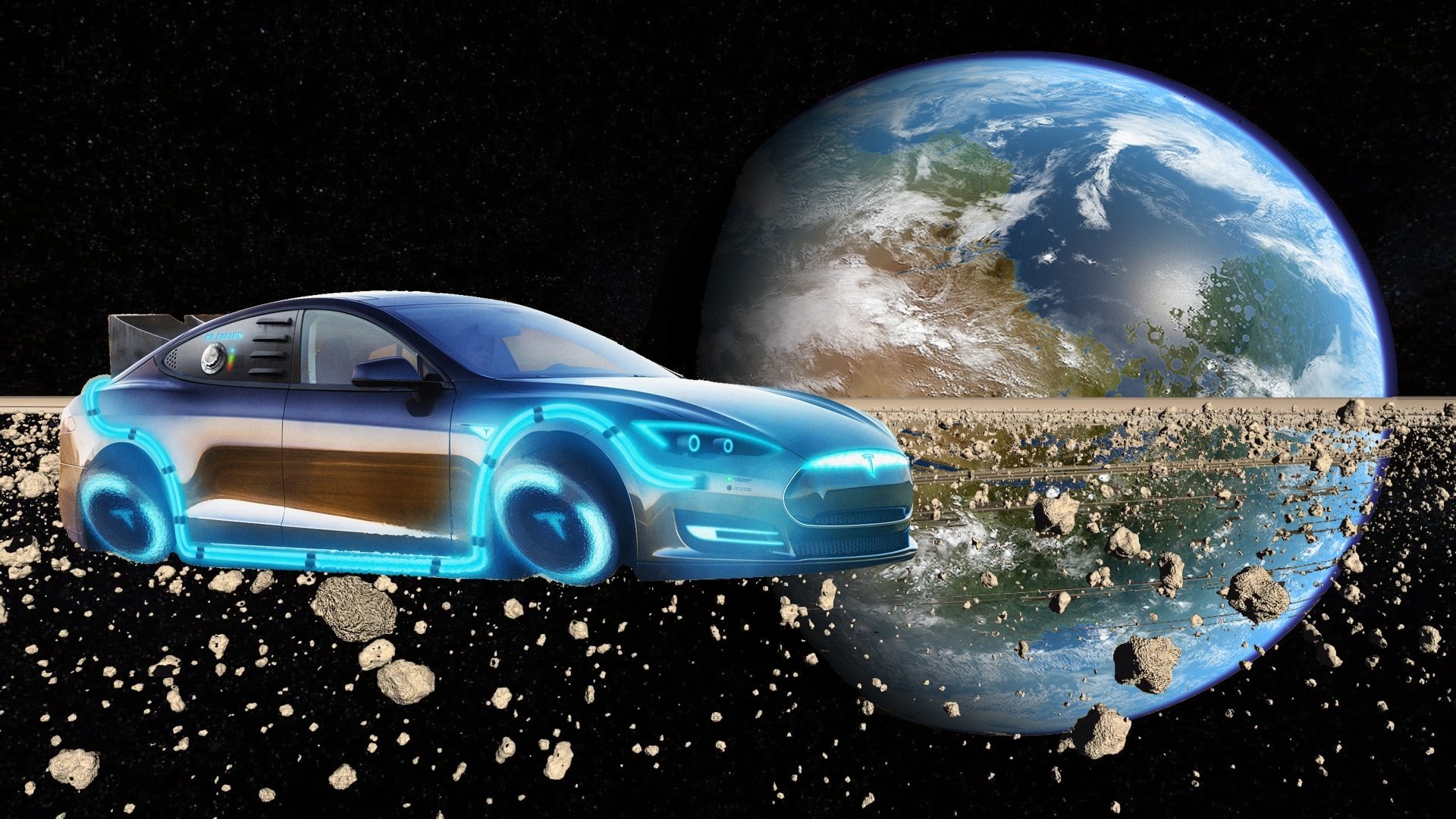
Somewhere in Mars orbit after 50 million years.
Until recently, the climate of the solar system planets was considered practically unchanged: it was only in 1920 that Milutin Milankovitch proposed the idea that changes in the eccentricity of the orbit, the tilt of the axis of rotation of the Earth and its precession, summed up cyclical climate changes (in fact, similar assumptions were expressed before but the lack of data did not allow to formulate this rule correctly before). This pattern was named after its author - Milankovitch cycles.. In 1950, Dirk Brauer and Adrianus Van Voerkam suggested that the eccentricity of the Martian orbit also changes with time, leading to changes in its climate. But at that time it was impossible to confirm or deny this — before the passage of Mars, the first Earth probe Mariner 4, there were still 15 years left.
Thanks to my good friend Dilyara Sadrieva , you can watch this article in video format.
However, even the first flying missions transmitted pictures of too low quality to lift the veil of secrecy on this issue. But already Mariner 9 (for the first time among Earth probes that went into the Martian orbit and worked on it from November 14, 1971 to October 27, 1972) managed to transfer more than 7 thousand images of decent quality with a resolution of 100-1000 meters per pixel. For fans of "Aelita" Alexei Tolstoy and "War of the Worlds"HG Wells news turned out to be disappointing: the channels discovered by Giovanni Schiaparelli on Mars turned out to be just an optical illusion, and Mars itself appeared to humanity as a lifeless desert. Temperature fluctuations on the planet ranged from -143 ° C at the poles in winter to + 35 ° C on a sunny day at the equator in summer, and the atmospheric pressure over most of the planet was so low that water ice turned into vapor and back bypassing the liquid phase.
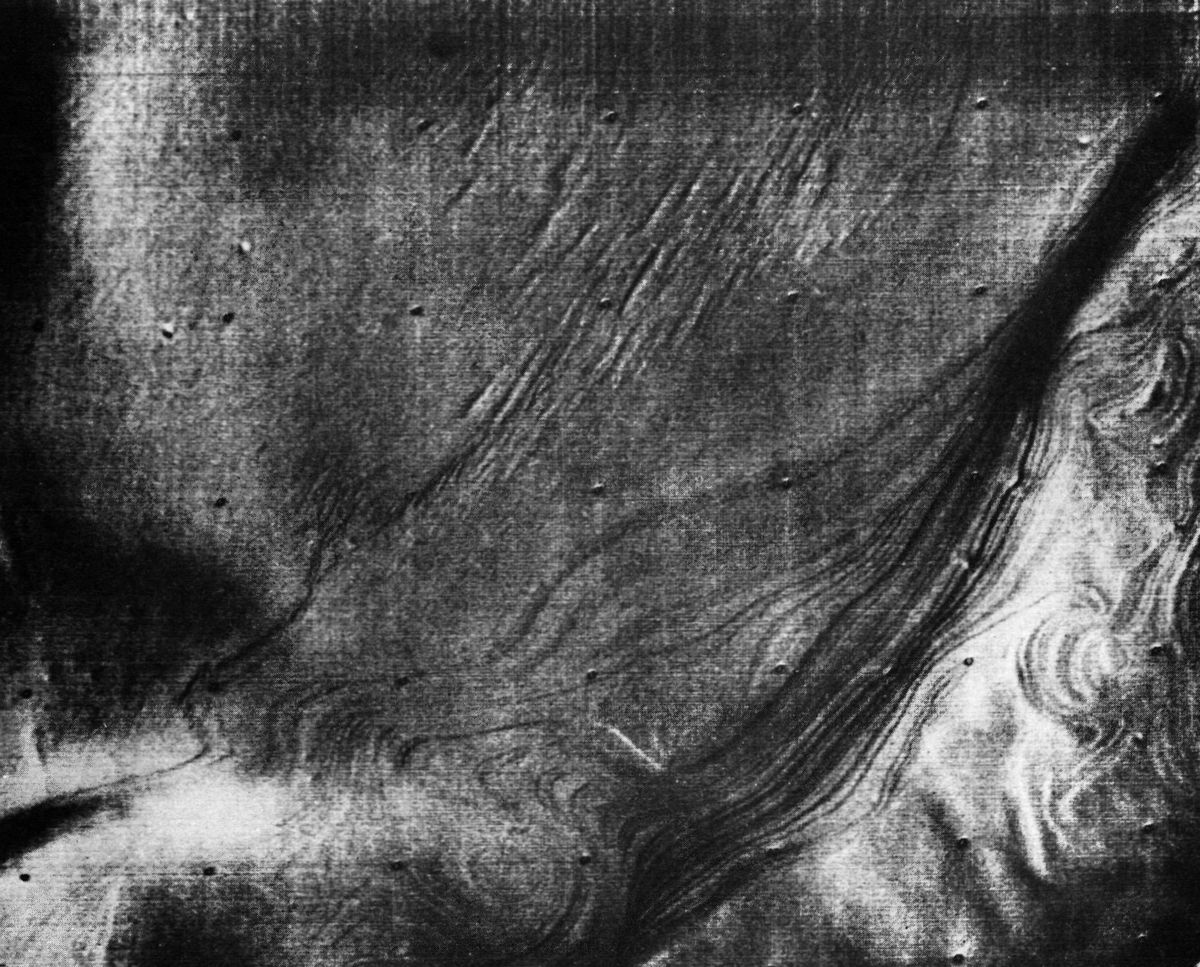
The first traces of the inconstancy of the Martian climate obtained by “Mariner-9”: the picture clearly shows the layered structure of the polar caps going from the upper right corner of the picture to the center of its lower part.
However, there was some good news: the device managed to photograph more than 70% of the Martian surface, including the polar caps. There were almost no craters on them, which indicated their young age (it was estimated at 20 million years). Also everywhere, starting from the 80th parallel up to the poles, a layered structure was fixed - this meant that the polar caps of Mars are not only very young formations, but also periodically changed during this period. The theory of the variability of the Martian climate began to be confirmed.

The first simulations gave changes in eccentricity in the range of 0.004-0.141, which almost coincided with the modern estimates of 0-0.16. The current value of the eccentricity for Mars is estimated at 0.0934 - it is still very important compared to the Earth's 0,0167 and it is second only to Mercury. It was on the basis of the observations of Tycho Brahe of the Mars movement that Johann Kepler was able to come to the conclusion that the orbits of the planets are elliptical, rather than circular, which later allowed him to compose three of his famous laws .
The cyclical nature of changes in eccentricity was also correctly determined by two periods of 95 thousand and 2 million years (although due to difficulties in measuring the deposition rate of rocks in the polar caps of Mars, errors were estimated to be as much as two orders of magnitudequantities). But the changes in the inclination of the orbit were estimated incorrectly: due to the understatement of the effect of precession on this parameter, the first calculations of the researchers gave only 15-35 ° instead of modern 0-80 °.

Animation of the precession of the axis of rotation of the Earth. Mars is going in the opposite direction.
Despite the fact that Mars weighs almost 10 times less than Earth, its cycles take much longer. For the Earth, the precession cycle takes 25,800 years , while for Mars it is as much as 56,600 years (the precession speed is 50.3 angular seconds for the Earth and 8.26 angular secondsfor Mars, respectively). The cycle of change of the axis of the Earth’s tilt is 41 thousand years, and Mars has 124 thousand. The precession of the axis of rotation of the planet leads to interesting effects: the gradual change of the axis of rotation of the planet associated with it leads to the fact that the title of the "polar" star eventually moves from one of them to another. At the same time, it gradually “drifts” and the beginning of the seasons: on Earth, they shift backward by 1 day every 70.5 years, and on Mars, on the contrary, they shift 1 day forward every 83.3 years. The rate of change in this case almost coincides with the fact that the Martian year itself is 1.8 times longer than the earthly one.
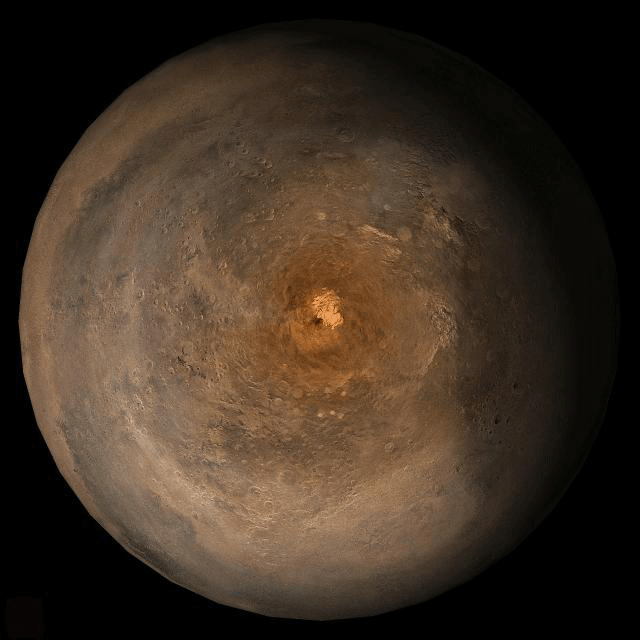
Evolution of the south polar cap from the Mars Global Surveyor images .
Due to the high eccentricity of the Martian orbit coinciding in aphelion(the most distant point of the orbit from the Sun) with winter in the southern hemisphere, leads to the fact that the climate in this hemisphere is more severe, and the southern polar cap is much larger than the northern one in size. Among other interesting features: the duration of the day on Mars is 37.4 minutes longer than Earth’s, but further the gap will decrease, as the rotation of Mars slows down at a speed of 3 orders of magnitude less than that of the Earth, which is associated with a small mass of two Mars satellites compared to our moon.
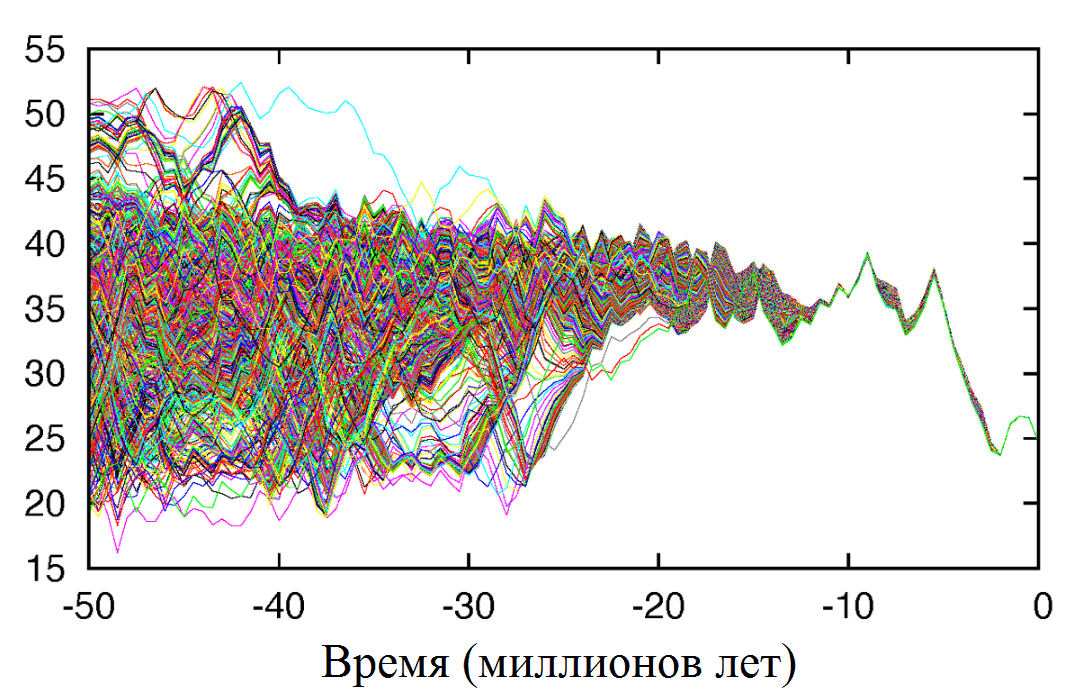
1001 simulation of changes in the inclination of the axis of rotation of Mars.
In 1989, Lascar set that the parameters of the terrestrial planetschange chaotically (mainly due to the influence of the randomly moving asteroids West and Ceres, which are influenced by the objects of the asteroid belt). This leads to the fact that pinpoint changes inclination of the axis and the eccentricity of Mars for more than 10 million years is not possible (this period is called the Lyapunov time ) and for the period of more than 50 million years, it becomes impossible to be more or less accurately determine even the statistical distribution of the values ( for the Earth, these intervals are 50 and 250 million years, respectively). But for periods within 10 million years, the characteristics of the orbits of all the planets of the solar system can be determined with sufficiently high accuracy.
Studies of these indicators for other planets also gavevery interesting results: despite the fact that the parameters of the orbits of the giant planets remain virtually unchanged, for Mars and Mercury, their eccentricities fluctuated within very wide limits. And for Mercury, they were so great at all that they could at intervals of billions of years lead to the fact that it could be thrown out of the solar system as it approached Venus (this probability was in the past and persists in the future). It can also allow us to take a different look at the Fermi paradox (the problem of why we do not find traces of life in other stars), since for the emergence of life on the planet it turns out that it not only needs to form in the habitable zone with its star, but also to be in a quasi-stable state with other planets in order not to fall out of it.
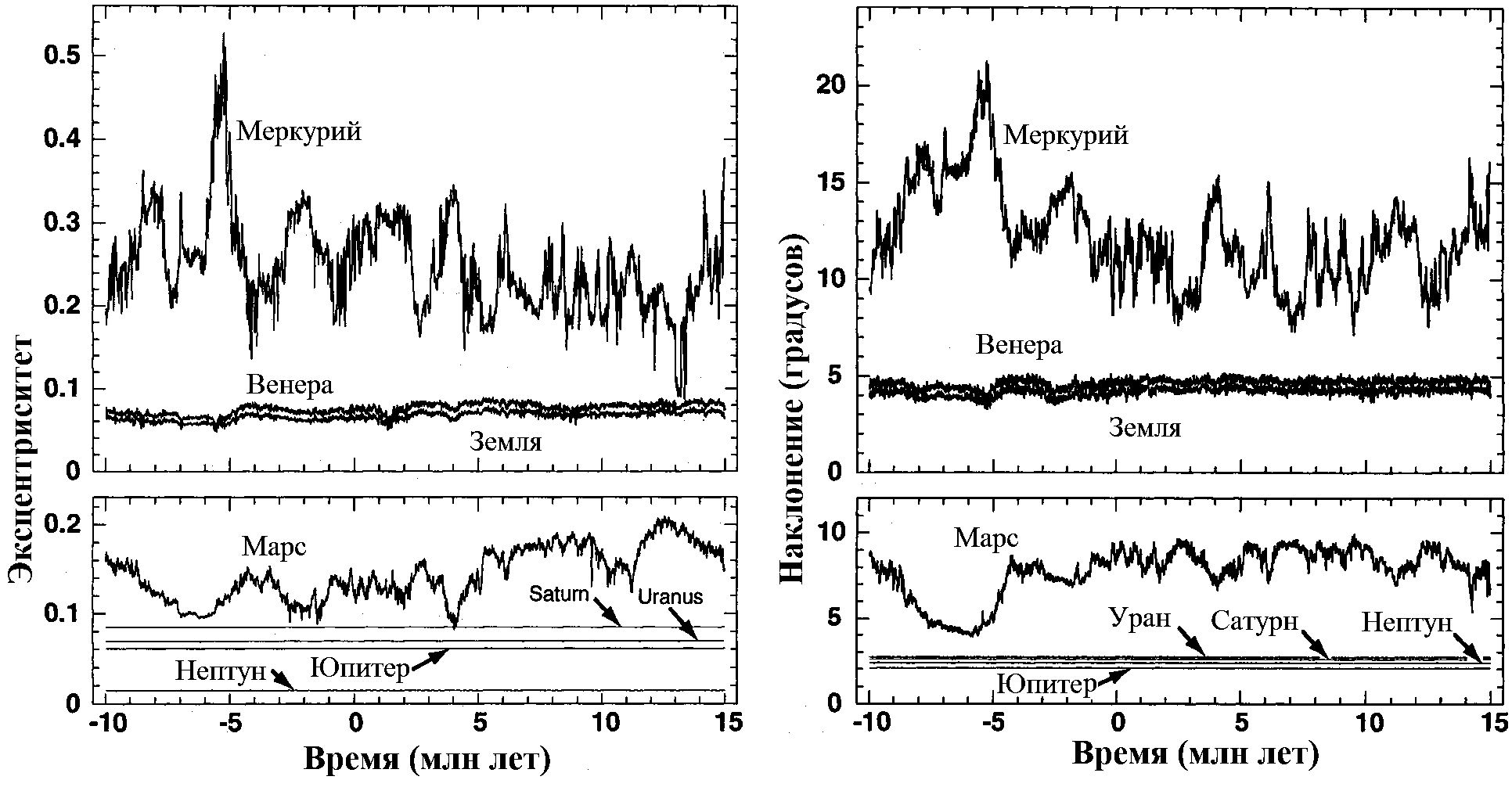
But back to Mars. According to estimates, the original atmosphere of Mars had a pressure of 6 times the current Earth, but as a result of the late heavy bombardment with asteroids and comets (which happened 3.8 billion years ago) Mars lost most of it retaining a pressure of 0.5-1 Earth's atmosphere (500- 1000 mbar ). But now we are seeing an average pressure at the Martian surface of only 6 mbar - where did the rest go? Until recently, the main reason for the loss of the Martian atmosphere was the disappearance of the magnetic field, which ceased to prevent the atmosphere from "blowing off" under the influence of the solar wind.
But as further studies have shown, the absence of a magnetic field on the contrary slows downits rate of volatilization: measured by satellite MAVEN for the first 2 years of its work, the loss of the atmosphere averaged 2193 tons per year. Even if we take into account that these measurements were made on the decline of solar activity, and the average value will be several times higher, this is still not enough: the previous estimates of scientists, based on a loss level of 568 tons per year in the solar minimum in modern times, gave a total loss of carbon dioxide from the atmosphere in the amount of 0.8-43 mbar over the previous 3.5 billion years. That is, extrapolating their estimates for the MAVEN data obtained (which turned out to be 3.86 times higher), we get a leak at 31-166 mbar during this period, against the minimum missing 500 mbar.
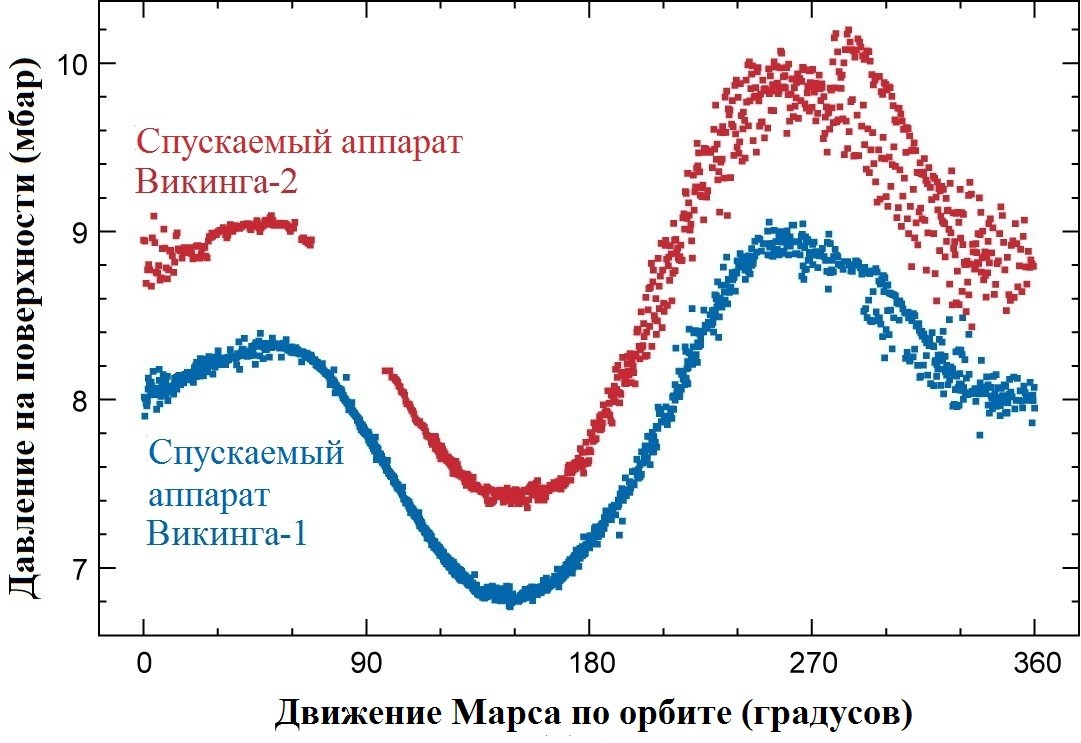
The change in atmospheric pressure for the Martian year. The difference in testimony is due to the fact that Viking-2 was located 900 meters below the average level of the Martian surface than its fellow Viking-1.
What other suspects are there? The Viking landing platforms found that the Martian soil contains a significant proportion of montmorillonite clays, which can adsorb a significant mass of carbon dioxide from the atmosphere. So besides 4-5 mbar wandering from pole to pole in polar caps (according to newer data there can be up to 85 mbar ) and 6 mbar in the atmosphere, it is assumed that about 300 mbarcarbon dioxide from the atmosphere was absorbed by the soil and another 130 mbar turned into carbonates in it. Estimates of the total current carbon dioxide reserves on Mars by various scientists vary within fairly wide limits: from ≤200 to ≥450 mbar . But before that, they altogether ranged from 200 to 10,000 mbar .
The reason for this spread was our poor knowledge of the internal structure of the “Red Planet”. Even now, even though we have not bad studied the polar caps of Mars, as well as the near-surface layers of Mars throughout its area to a depth of a couple of meters, our knowledge of its internal structure leaves much to be desired, which is why the spread of estimates is still large. Opening the curtain on this issue should be the landing platform «InSight»which landed on Mars on November 26th. Onboard the InSight are a sensitive seismometer and a folding 5-meter drill (chemical analysis of the soil is not collected in this case, but measuring the physical properties of the soil at such depths will be a big step for us). “How does all this affect the Martian climate?” - you can ask. The point here is that the eccentricity depends on how closely the planet approaches the Sun and how much time per revolution it spends in this position. Thus, eccentricity affects the climate of the planet as a whole, and the tilt of the axis affects its latitudinal distribution: when the tilt of the axis of rotation of the planet reaches 54 °
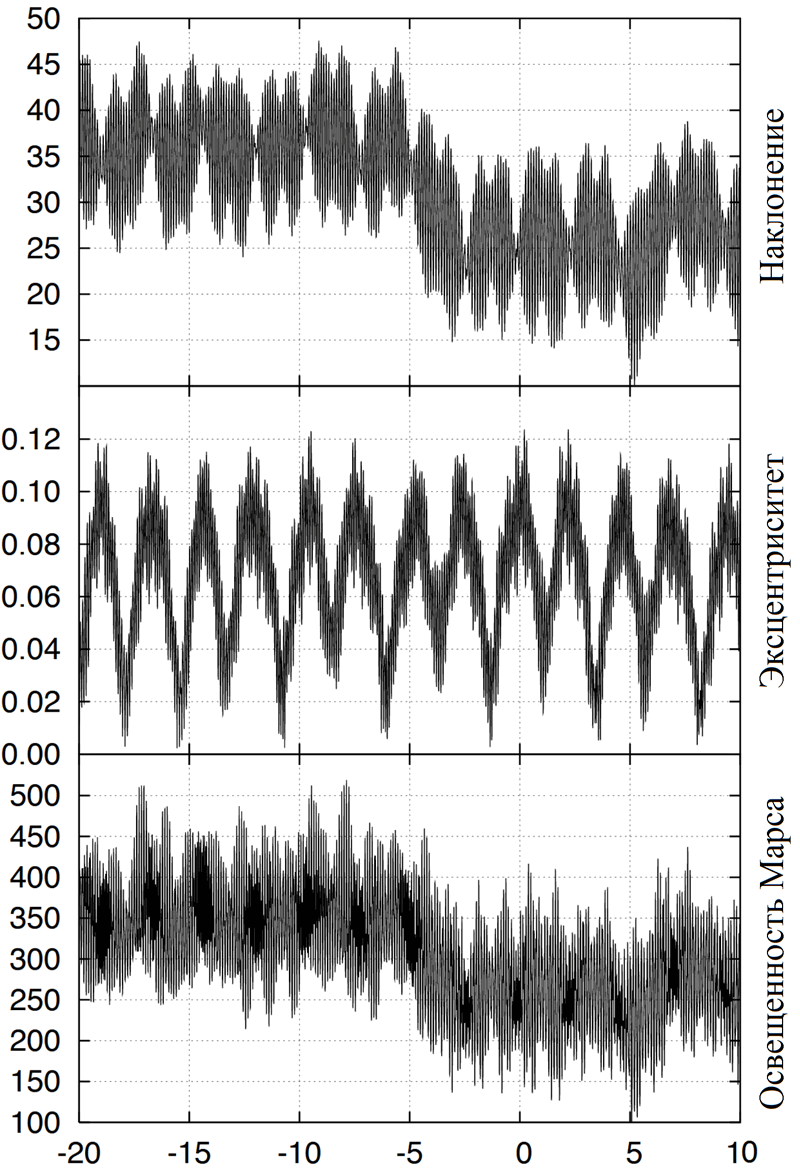
the poles of the planet begin to receive the same amount of sunlight as the equator. And with a further increase in the slope - even more than him. Thus, the climate at the poles becomes warmer than at the equator, which in turn leads to the melting of the upper layer of the polar caps consisting of “dry ice” (frozen carbon dioxide). And since carbon dioxide is a greenhouse gas, its release causes warming throughout the planet as a whole.
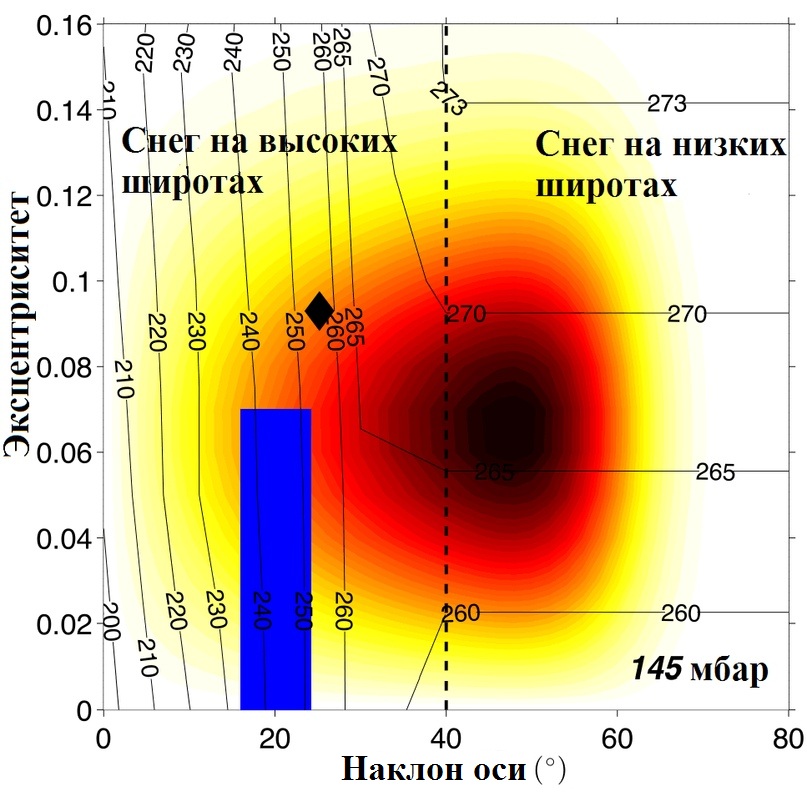
The graph of annual peaks of temperatures in the areas of the polar caps according to a 2012 study . The highest temperatures are highlighted in black, and the middle temperatures are red and yellow, and low temperatures are white (with the diamond indicating the current state of Mars). The blue rectangle indicates the interval for changing the parameters of eccentricity and inclination near the Earth.
For all factors, the optimal parameters for heating Mars are the average value of eccentricity (0.06-0.08) and the coincidence of the orbit perihelion with the day of the equinox (0 ° or 360 °), but in general these parameters have a much smaller influence on the climate. The current values for Mars are 25.19 ° axis tilt, eccentricity of 0.0934 and perihelion 286.502 °. The eccentricity of the orbit of Mars is now moving to its peak at 0.105 (which should reach 24 thousand years later), after which it will move back to the indicator of 0.002 (which will reach 100 thousand years later). Unfortunately, the slope of Mars is now in its quiet phase, near a cycle minimum of 2 million years, and does not plan to rise above 36 ° in the near future. So, in the foreseeable future, Mars should remain an endless desert for us.

Sand vortex filmed by the Spirit rover on May 15, 2005. Gif displays the process of movement of the vortex in 9.5 minutes (the interval between frames is about half a minute).
However, this does not mean that the climate of Mars will not change in the near future. More precisely it is changing now: the period from the latest information from the "Viking" in 1977 and prior to receipt of the first data from the probe "Mars Global Surveyor" in 1999, the Martian surface temperature has risen to the C ° 0.86 . This process is not directly related to the phenomena described above - scientists have found an explanation for it in the albedo changeMars (the degree of reflectivity of its surface) which as it turned out over these 22 years has changed by more than 10% up or down on a third of the Martian surface.
This change does not portend so far to make the terraforming of Mars much easier, because according to preliminary estimates by scientists, it is required to raise the surface temperature by as much as 25 ° C - otherwise, after removing the external influence, Mars will return to its original cold state. The change in the albedo of Mars seems to be due to dust storms, and as seen in the photographs, the south polar cap ( formed during the period of the year when a global dust storm occurs on Mars) becomes dirtier than the north.
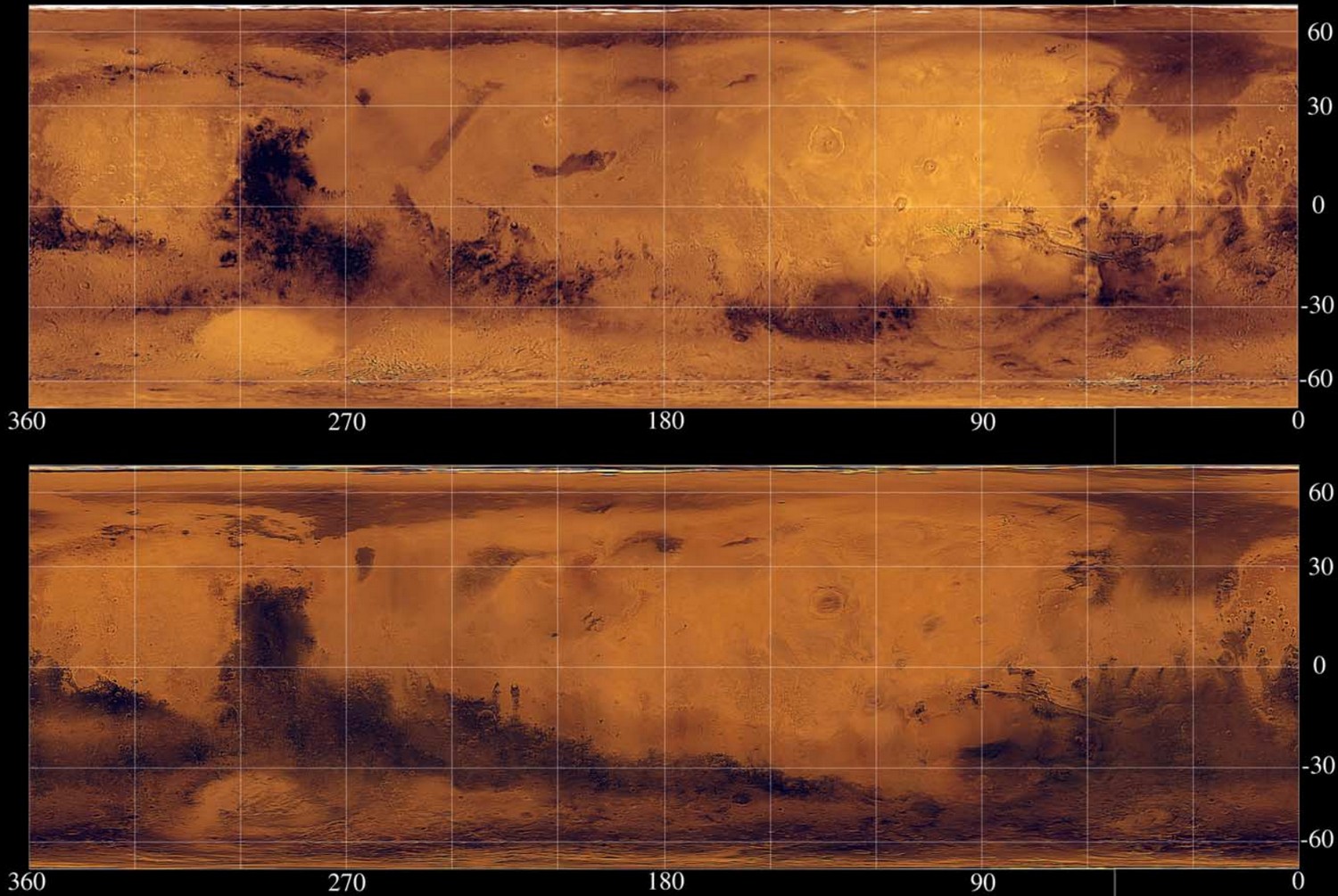
Now these data are based on only two time points and it is too early to talk about any patterns. However, studies of eccentricity and tilt cycles also suggest that global warming is occurring on Mars right now, but at a much slower rate: The
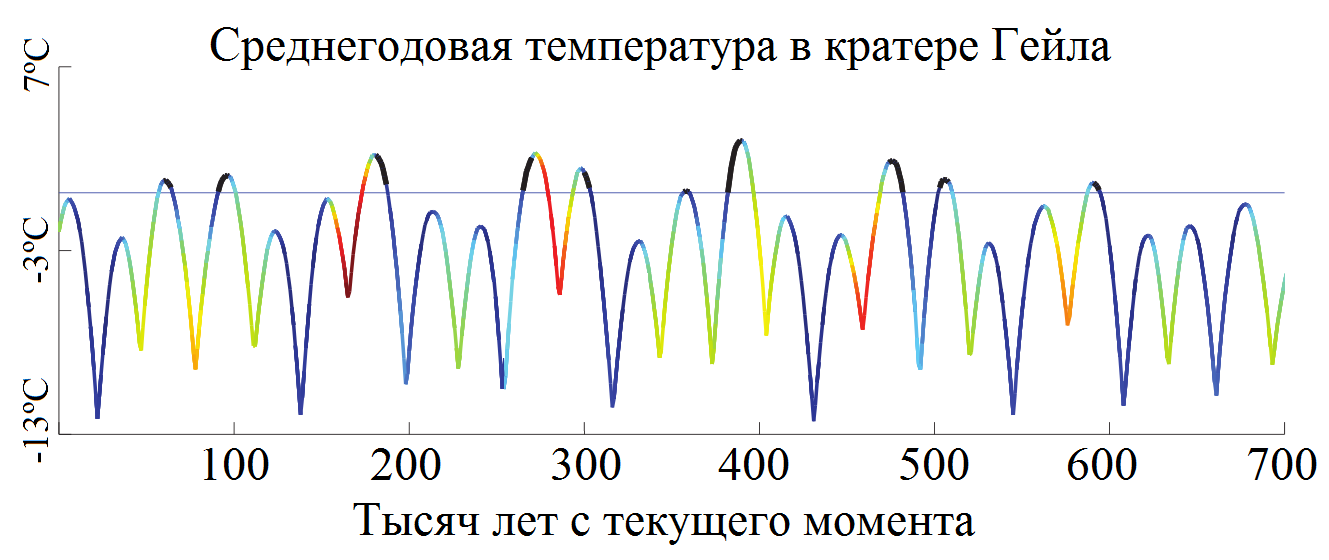
blue line is the temperature at which the permafrost begins to melt in the Gale crater, located 5 ° south of equator (obtained according to the data of Curiosity ).
What can give us this small peak on the graph, to which we are now moving? Generally speaking, quite a bit. With an increase in the average temperature on Mars, global warming should also occur there, as on Earth: with an atmospheric pressure of 6.1 mbar and a temperature of 158 ° K in Martian soil it can adsorb up to 11 cm³ of carbon dioxide per gram of soil, but at a temperature of at 196 ° K, saturation occurs already at 3.5 cm³ per gram. Thus, the heating of the soil will cause the release of greenhouse gas accumulated in it. However, in general, from this small increase in the average temperature, the effect itself will be insignificant. Moreover, due to the limited thermal conductivity of the soil, it does not heat up instantaneously, but at a speed of about 1 meter per year.
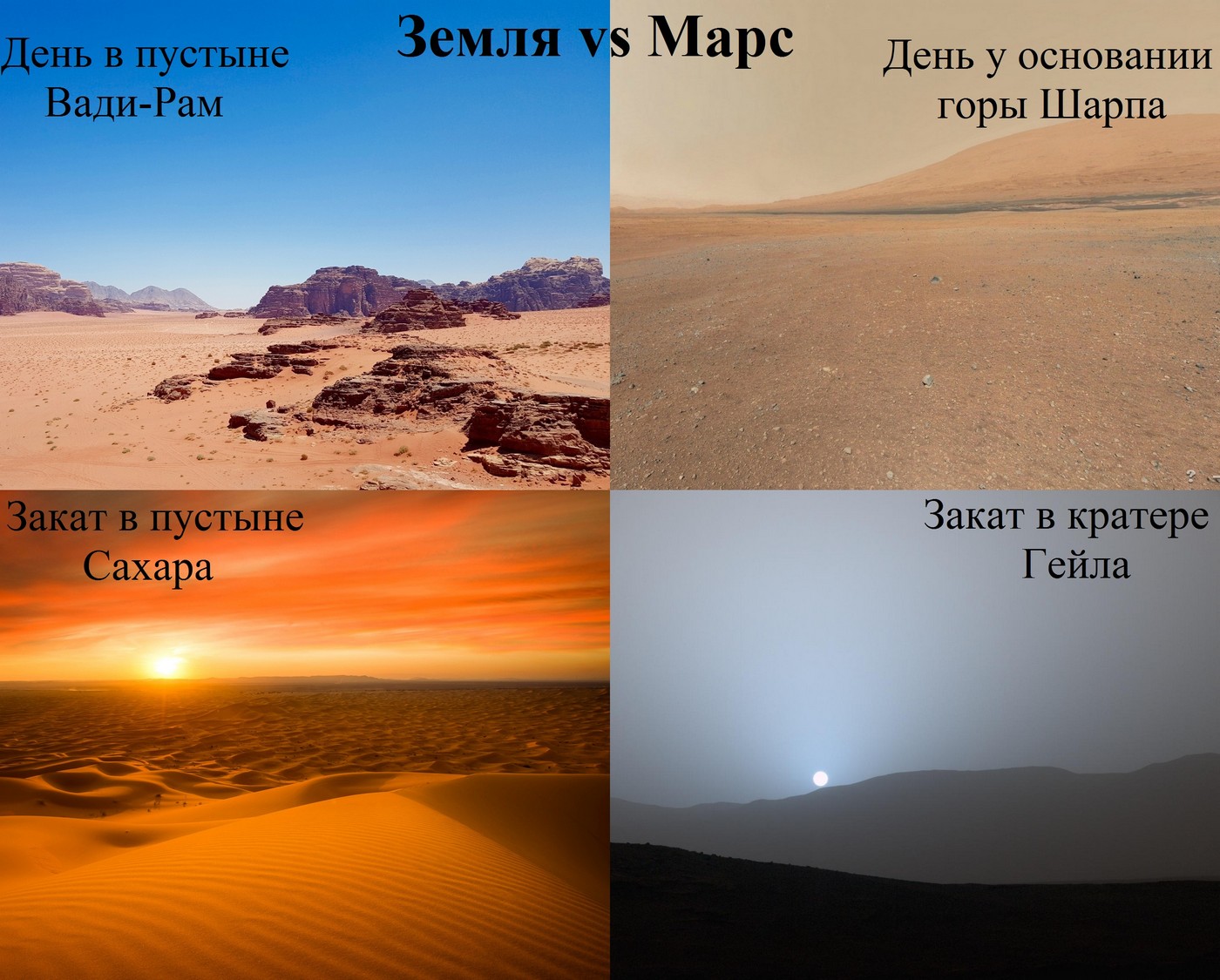
A suspension of dust in the Martian atmosphere makes his sky opposite to the earth.
In addition to the release of gases from the ground, one more effect that increases warming is possible: with a significant increase in atmospheric pressure, the famous global dust storms of Mars are estimated by scientists to decline. It should also raise the average temperature on the planet, since these storms can cover the entire planet for a period from a few earthly months to half a year, reflecting part of the world back into space. But perhaps even more important consequence of this may be that according to another recent study.these storms are a source of perchlorates on Mars, which are poisonous to humans and most life forms on Earth (including plants) in high concentrations. Thus, the climate warming on the “Red Planet” can directly serve to increase the fertility of its soil. However, this effect requires much more warming than will be achieved in the current temperature increase cycle, so this is more likely to be discussed in the context of the terraforming of Mars, which will be discussed in the next article.
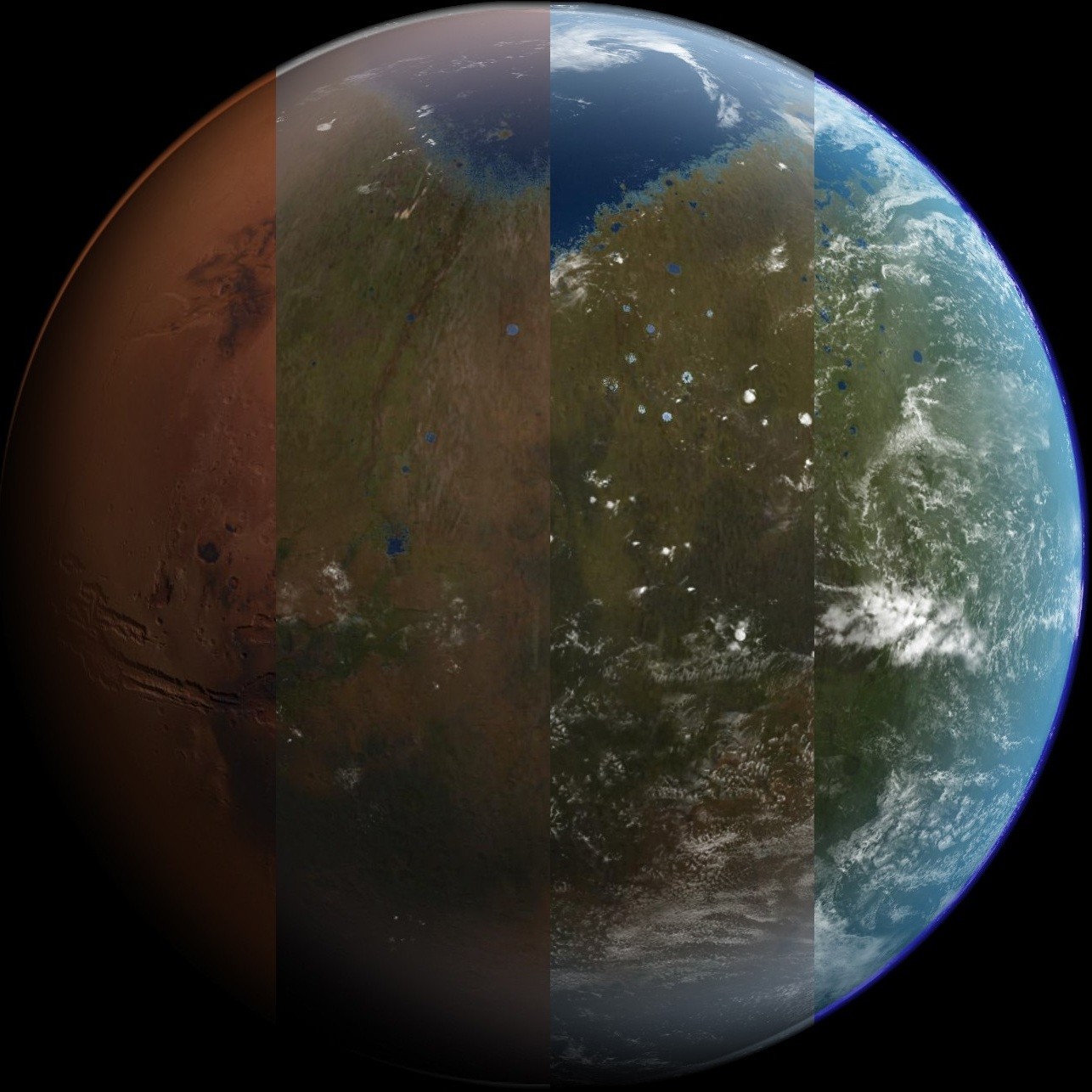
At the end of the article, I would like to invite anyone interested in research, colonization and terraforming of Mars to subscribe to the group of the Martian society on Facebook and VKontakte , and also to jointo our ranks or to become the coordinators of the Martian society in the regions in order to make a feasible contribution to the process of turning the “Red Planet” into the blue-green one. To do this, you can contact me or Alex .
Climate infographic in Gale crater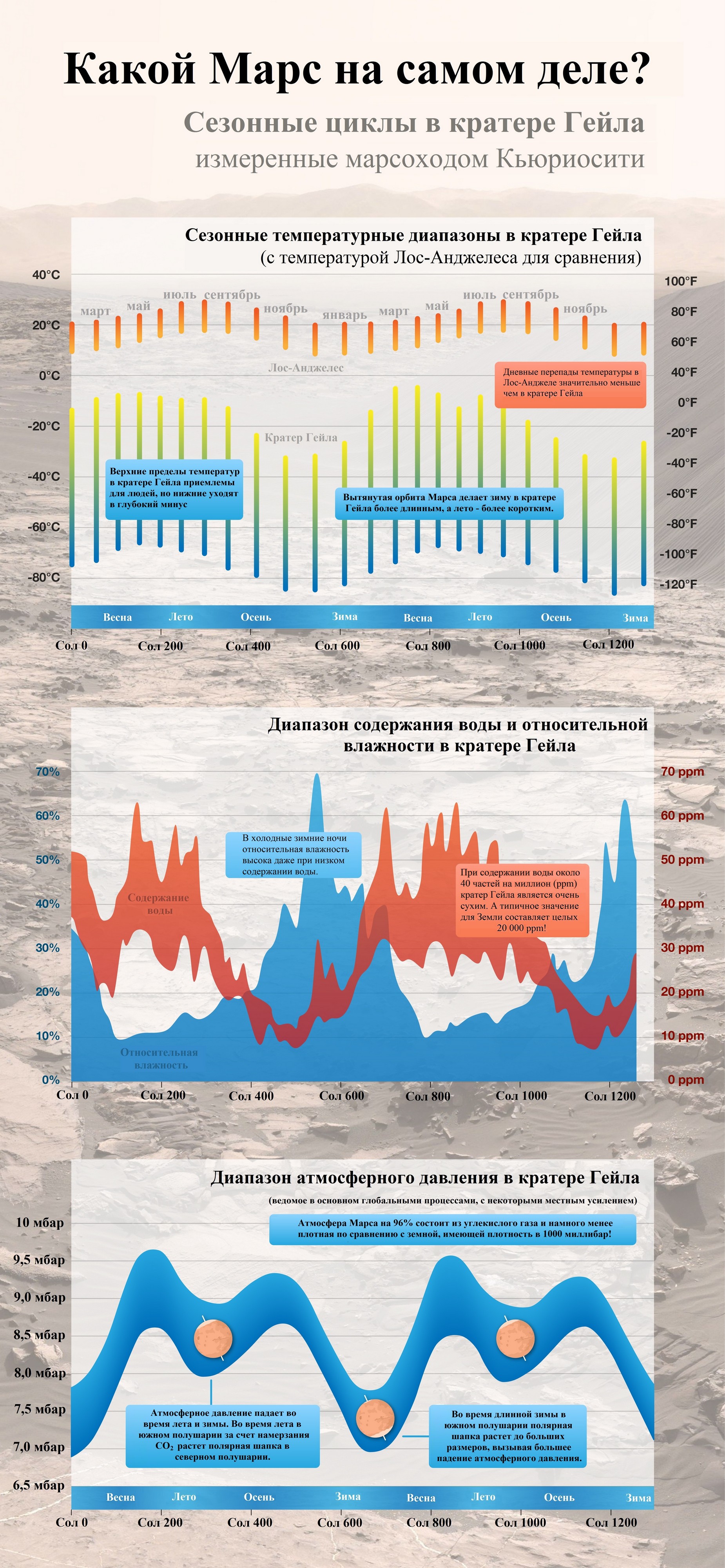

References to the used literature
Orbital forcing of the martian polar layered deposits.
Periodic insolation variations on Mars.
Climatic variations on Mars: 1. Astronomical theory of insolation.
Solar luminosity variation and the climate of Mars.
The astronomical theory of climatic change on Mars.
Periodic climate change on Mars: review of evidence and effects on distribution of volatiles.
Making Mars habitable.
A model for the evolution of CO2 on Mars.
The chaotic obliquity of Mars.
Large-scale chaos in the Solar system.
Retention of an atmosphere on early Mars.
Stability and evolution of the climate system of Mars.
Long term evolution and chaotic diffusion of the insolation quantities of Mars.
Three decades of Martian surface changes.
Thick and thin models of the evolution of carbon dioxide on Mars.
Encyclopedia of paleoclimatology and ancient environments.
Martian atmospheric erosion rates.
Global warming and climate forcing by recent albedo changes on Mars.
Massive CO2 ice deposits sequestered in the South polar layered deposits of Mars.
Forming perchlorates on Mars through plasma chemistry during dust events
Seasonal melting and the formation of sedimentary rocks on Mars, with predictions for the Gale crater mound.
Long-term evolution of Mars eccentricity and obliquity.
Построение модели вековых возмущений планетных орбит.
Mars atmosphere: History and surface interactions.
On Mars atmospheric sputtering after MAVEN first two years.
Статья «Global warming on Mars» на сайте SkepticalScience.com
Periodic insolation variations on Mars.
Climatic variations on Mars: 1. Astronomical theory of insolation.
Solar luminosity variation and the climate of Mars.
The astronomical theory of climatic change on Mars.
Periodic climate change on Mars: review of evidence and effects on distribution of volatiles.
Making Mars habitable.
A model for the evolution of CO2 on Mars.
The chaotic obliquity of Mars.
Large-scale chaos in the Solar system.
Retention of an atmosphere on early Mars.
Stability and evolution of the climate system of Mars.
Long term evolution and chaotic diffusion of the insolation quantities of Mars.
Three decades of Martian surface changes.
Thick and thin models of the evolution of carbon dioxide on Mars.
Encyclopedia of paleoclimatology and ancient environments.
Martian atmospheric erosion rates.
Global warming and climate forcing by recent albedo changes on Mars.
Massive CO2 ice deposits sequestered in the South polar layered deposits of Mars.
Forming perchlorates on Mars through plasma chemistry during dust events
Seasonal melting and the formation of sedimentary rocks on Mars, with predictions for the Gale crater mound.
Long-term evolution of Mars eccentricity and obliquity.
Построение модели вековых возмущений планетных орбит.
Mars atmosphere: History and surface interactions.
On Mars atmospheric sputtering after MAVEN first two years.
Статья «Global warming on Mars» на сайте SkepticalScience.com
